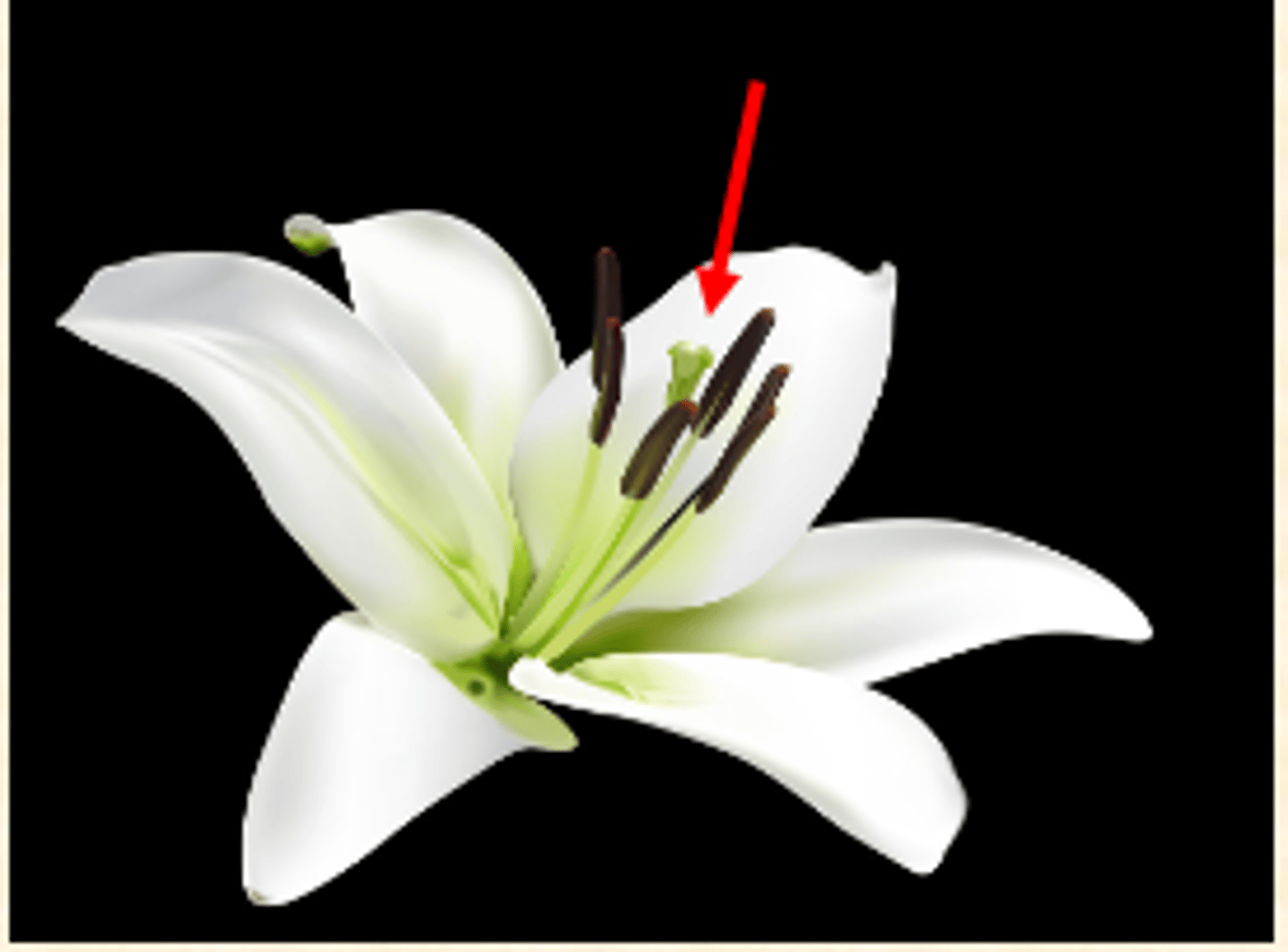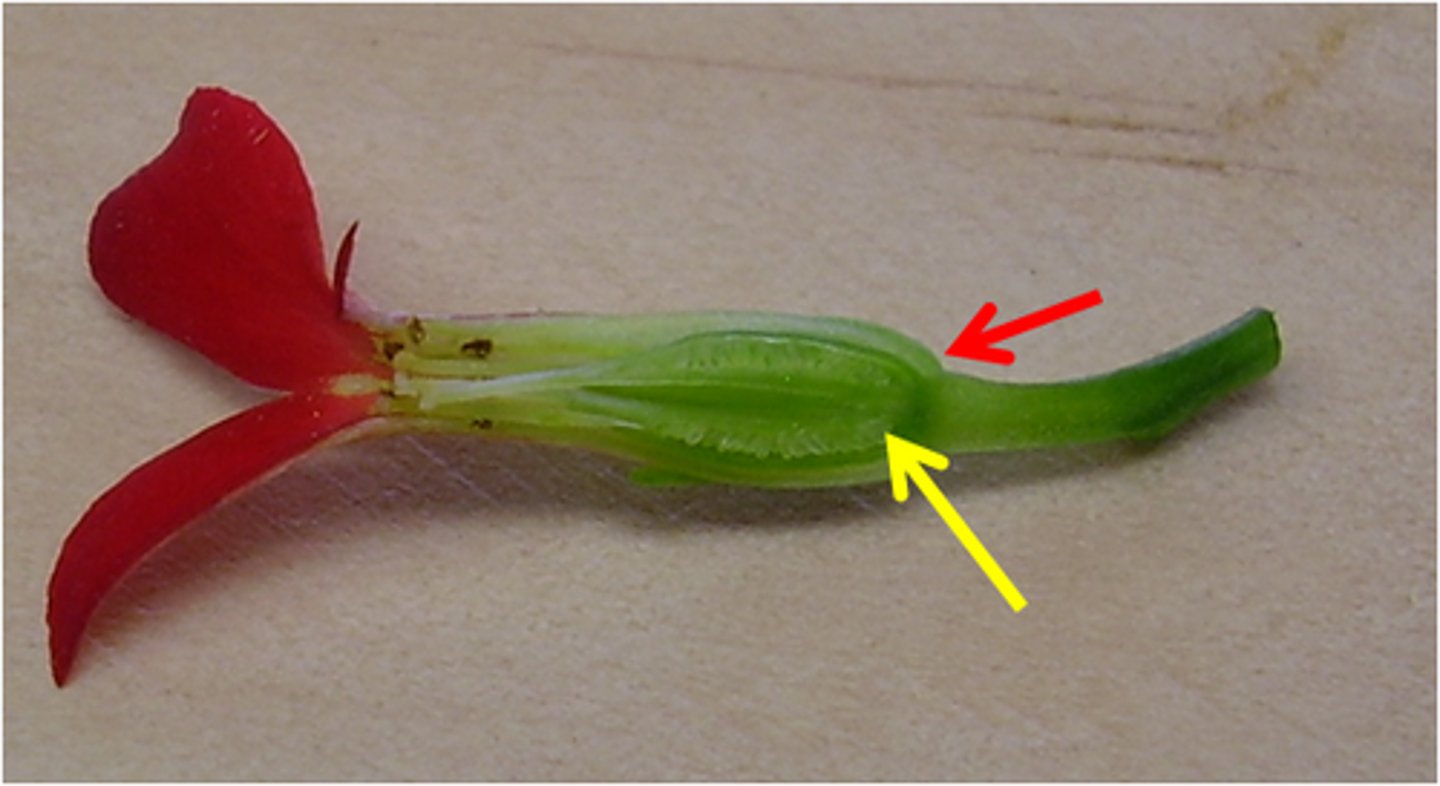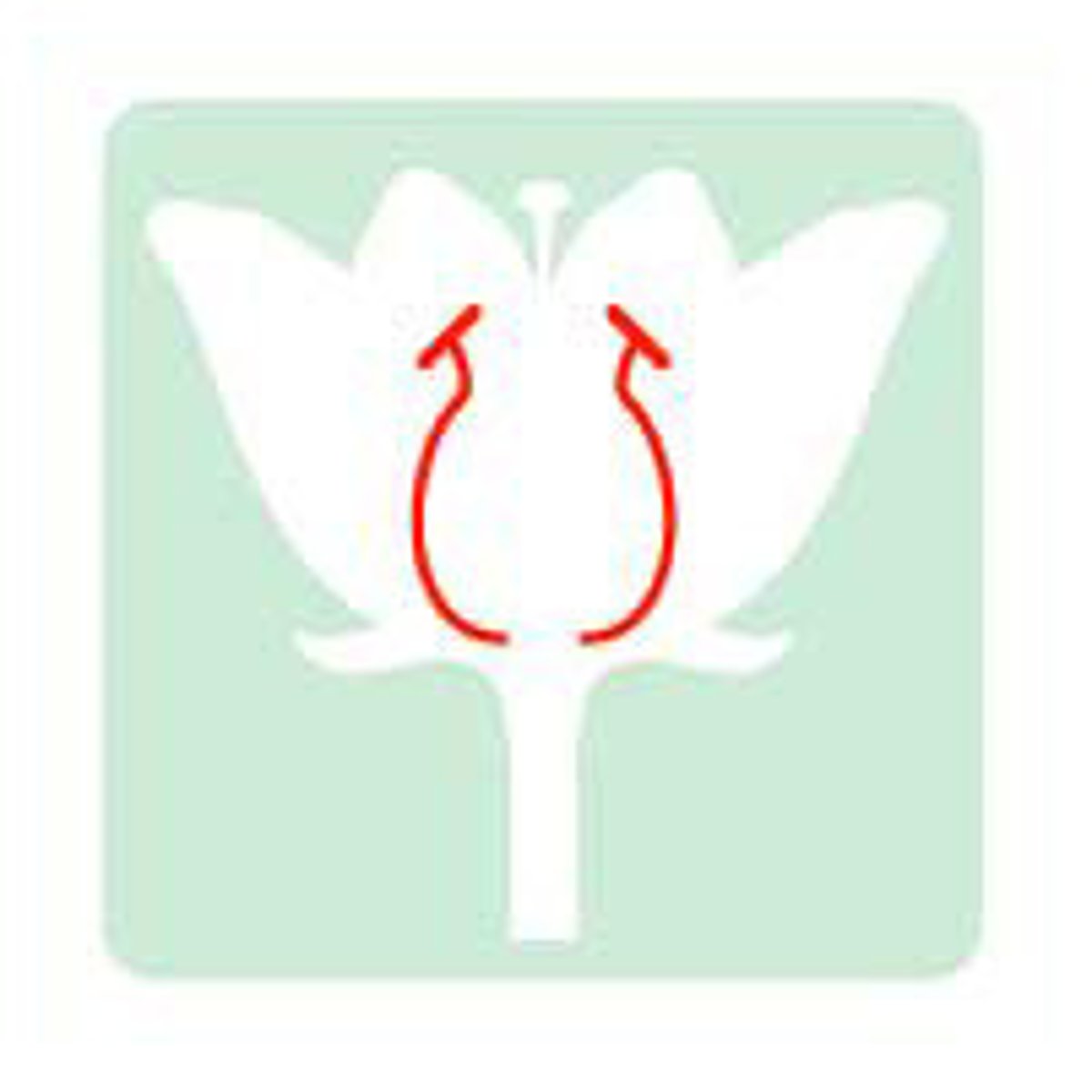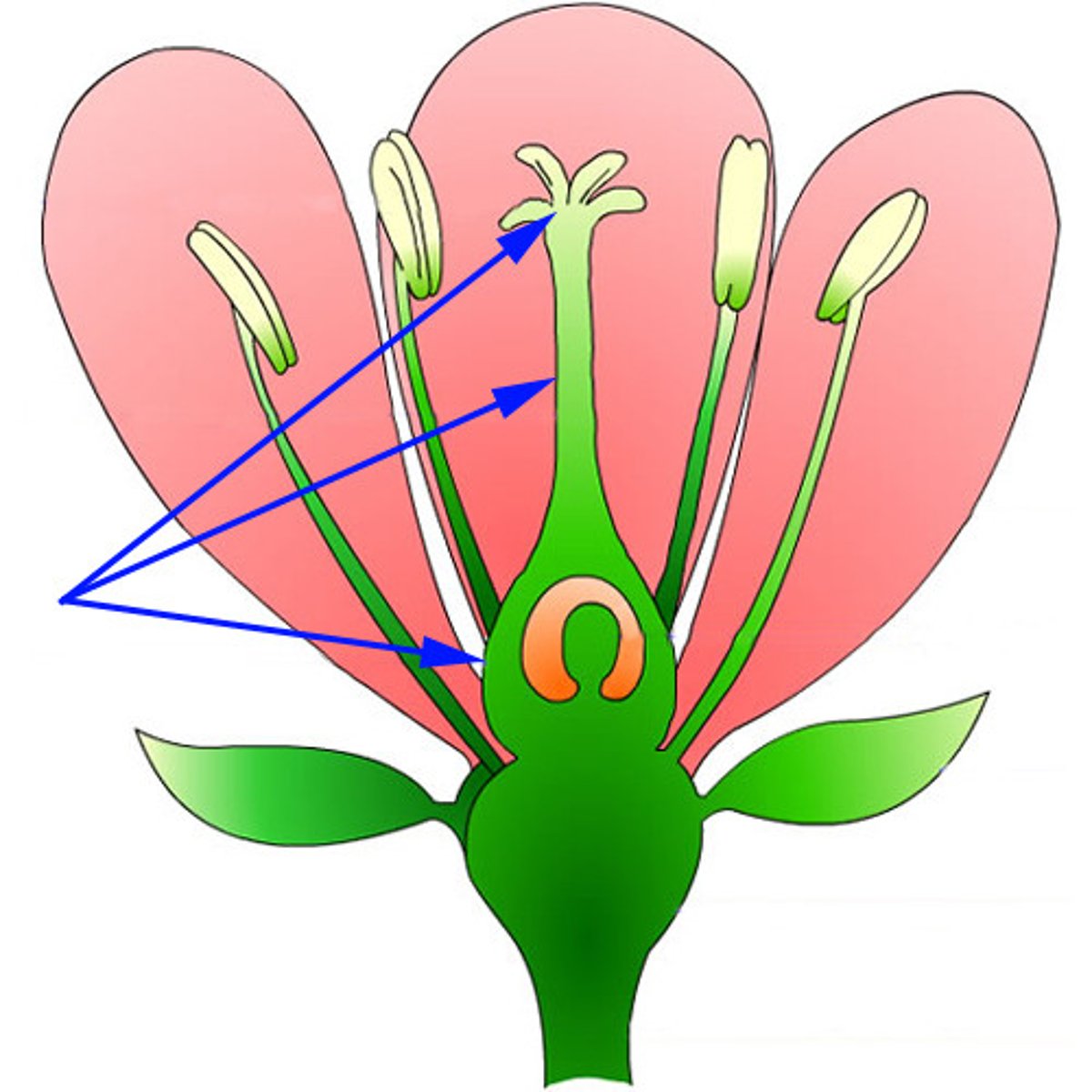ENVS 150 Plant Science Final Exam
1/155
There's no tags or description
Looks like no tags are added yet.
Name | Mastery | Learn | Test | Matching | Spaced |
|---|
No study sessions yet.
156 Terms
Petal
What plant part is this picture pointing to?

Sepal
What plant part is this picture pointing to?

Stamen
What plant part is this picture pointing to?

Pistils
What plant part is this picture pointing to?

-Petals
-Sepals
-Stamens
-Pistils
What are the four major flower parts?
-Petals are modified leaves that form an inner whorl surrounding the reproductive parts of flowers. They are often brightly colored or unusually shaped to attract pollinators.
-The corolla refers to all the petals in a flower.
Describe the petals of a flower. What do they do?
-The sepal is a leaf-shaped structure found in flowering plants, or angiosperms. It is found on the outermost part of the flower, and like a petal, a sepal is considered to be a modified leaf. However, sepals are more likely to be confused with leaves since they are typically, but not always, green.
-The calyx refers to all the sepals in a flower
Describe the sepals of a flower. What do they do?
Male reproductive parts of the flower consists of a stalk called the filament and an anther which contains microsporangia
Describe the stamen of a flower. What do they do?
Female Reproductive parts of the flower centrally located typically consists of a swollen base, the ovary, which contains the potential seeds, a style, a stalk arising from the ovary, and the stigma, a pollen-receptive tip which is variously shaped and often sticky.
Describe the pistil of a flower. What do they do?
only has male parts
What does the term Staminate flower mean?
only has female parts
What does the term Pistillate flower mean?
a. Color: Blue or Yellow
b. Structure: Petals showy with nectar guides visible in UV light
c. Nectar: yes
d. Odor: sweet
What are the characteristics of flowers pollinated by Bees?
a. Color: Dull
b. Structure: Exposed anthers and stigmas feathery stigmas in some
c. Nectar: no
d. Odor: odorless
What are the characteristics of flowers pollinated by wind?
a. Color: white
b. Structure: petals used as landing platforms, have long floral tubes to hold nectar, open at night
c. Nectar: yes
d. Odor: Heavy musky odor
What are the characteristics of flowers pollinated by Moths?
Physiological dormancy
Out of the six kinds of dormancy discussed in this class, which is the most common type of dormancy in seed germination?
-In angiosperms, the pollen tube grows through the style into the embryo sac in the ovule and discharges two sperm nuclei. One fertilization produces the embryo, and the other fertilizes 2 female nuclei to make 3n endosperm.
-This only occurs in angiosperms.
What does the term double fertilization mean? Do angiosperms or gymnosperms have this type of fertilization?
-Low temperature (flowering too early)
-Lack of Pollinators
-Low light intensity
-Lack of adequate soil moisture
-High heat, high night temperatures
What are five negative effects that can affect fruit setting in plants?
a. Ex: Plum
b. Exocarp and Mesocarp are fleshy
c. Endocarp forms a solid pit with one seed
What are the characteristics and an example of a Drupe fruit (Stone fruit)?
a. Ex: Squash
b. Exocarp forms a rind
c. Mesocarp is fleshy
d. Seeds are distributed through the endocarp
What are the characteristics and an example of pepo fruit?
a. Ex: Orange
b. Exocarp and mesocarp from a rind
c. Seeds are distributed through the endocarp
What are the characteristics and an example of Hesperidium fruit?
having to identical alleles for a certain trait (PP, pp)
What does the word Homozygous mean? What does it look like written out?
having to different alleles for a certain train (Pp)
What does the word Heterozygous mean? What does it look like written out?
a. Dominant refers to the relationship between two versions of a gene, where one allele will be expressed and the effect of the other allele, called recessive, is masked.
b. Written: P
What does the term dominant mean? What does it look like written out?
a. Recessive traits require that both alleles be present to express the trait.
b. Written: p
What does the term recessive mean? What does it look like written out?
a. Rr
b. 50% (2/4 chances of getting an Rr flower)
Write out a one-character inheritance table (Punnett Square) for this example and answer the following questions:
A farmer has one white (rr) flower and one red (RR) flower for their P generation.
a. What genotype would their F1 generation have?
b. What probability would the farmer have of getting a red (Rr) flower in their F2 generation?
Meiosis is the process of gamete production
What does the term meiosis mean?
Synthesis or transcript messenger RNA (mRNA) from a gene
What does the term Transcription mean?
Synthesize protein by translation mRNA information
What does the term Translation mean?
RNA has Uracil instead of Thymine that DNA has
What is the biggest difference between DNA and RNA?
a. Individuals in a population vary in size because of their traits
b. Only a small percentage of offspring will survive and reproduce
c. Individuals compete for limited resources
d. Individuals best adapted to an environment will survive and reproduce in greatest numbers
What are the four basis of natural selection?
Unrelated organisms with similar appearance develop independently
What does the term convergent evolution mean?
a. More external qualities
b. Light: Quality, Quantity, Duration, & Direction
c. Mechanical: Wind, touch, Structures, & Herbivores
d. Soil: Nutrients & Water
e. Atmosphere: Temperature, Relative humidity, & Neighboring plants
f. Gravity
g. Air pollution
h. Pathogens
What are the characteristics of Exogenous signals?
a. More internal qualities
b. Hormones: Auxin, Cytokinin, Gibberellins, Abscisic acid, Ethylene, & Brassinosteroids
c. Mechanical: Growth induced & Tissue compression and tension
d. Defense signals: Jasmonic acids, Salicylic acid, & Secondary compounds
e. Maturity/Juvenility
What are the characteristics of Endogenous signals?
a. responsible for Phototropism by mediating responses to gravity and light
b. promotes cell division and enlargement
c. initiates root growth on stem cuttings and in tissue culture
d. Stimulates phloem and xylem differentiation
e. Promotes growth of flower parts
f. Promotes special dominance
g. Delays fruit ripening and abscission
h. Delays leaf senescence
i. High Auxin concentrations can stimulate ethylene production, which promotes senescence and can lead to plant death
What are the major roles of Auxin?
a. Stimulates shoot (stem) elongation by increasing cell division and cell elongation
b. Induces seed germination, fruit set and growth
c. Bolting (flowering) in long-day plants
d. Breaks bud dormancy
e. Can change fruit size and shape
What are the major roles of Gibberellin?
a. causes stomata to close in water stressed plants
b. increases root growth
c. inhibits shoot growth
d. inhibits seed germination
What are the major roles of abscisic acid?
a. Stimulates defense responses in stressed plants
b. Induces flowering in some plants
c. Stimulates stem thickening, stem elongation, and horizontal bending of stems
d. Makes fruit more juicy
e. Promotes senescence of leaves, flowers, and fruit, and also can cause fruit to overripen
What are the major roles of ethylene?
Stimulates positive phototropism
What does blue light do to plants?
Phototropins are the receptors
What are the receptors of blue light?
a. Controls seed germination, stem elongation, and flowering
b. part of photosynthesis
c. Red light (day) goes into the nucleus
d. Far-red light (night) goes into the cytoplasm
What do Red and far-red light do to plants?
Phytochrome is the receptor
What are the receptors of red and far-red light?
The percentage of sand, silt, and clay particles in a soil
What does the term soil texture mean?
Oxygen (O) Carbon (C) Hydrogen (H)
What are the 3 major components of all organic compounds; makes up 96% of a plant's dry weight?
occurs when plant leaves turn yellow due to a lack of chlorophyll.
What does the term Chlorosis mean?
premature death of cells
What does the term Necrosis mean?
nitrogen (N)
What is the most limiting nutrient in plants?
phosphorus (P)
What is the second most limiting nutrient?
phosphorus
What nutrient do mycorrhizal fungi help plants take up?
a. Positively charged particles
b. Bound to negative particles in the soil, which protects them from leaching
c. Not easily absorbed by roots
What does the term Cation mean?
a. Negatively charged particles
b. Readily dissolve in water
c. Easily absorbed by roots
d. Free floating in soil, so they are subject to leaching
What does the term Anion mean?
An important property of clay and the organic humus fraction of the soil is ability to attract and hold cations
What is cation exchange capacity?
High; low
When discussing osmosis, water will move from _____ water potential to _____ water potential.
climate
What is the most important factor determining where and how many species can live in an environment?
Ferrel cell
What 'cell' is responsible for the humid tropics at the equator and deserts 30N and 30S?
a. Large areas of land north of 65 degrees latitude in North America and Eurasia
b. Very little area in southern hemisphere
c. Growing season- up to three months
d. Permafrost—layer of permanently frozen ground
e. Rainfall is low <25 cm per year
f. Sumer 3 to 12 degrees C; winter -34 degrees C
g. <2,000 species of plants
h. Majority of biomass is underground
i. Low primary productivity and low resilience
What are the characteristics of the arctic tundra biome?
a. No trees
b. Mostly low growing shrubs: willows, birch, blueberry, labrador tea
c. Other plants: sedges, mosses, small perennial flowering plants
d. Lichens
What kinds of plants grow in the artic tundra biome?
a. Drier climate in able to support tree growth
b. between deserts and temperate forest
c. Dominate the interior of North America (prairie) and Eurasia (steppe)
d. Pronounced seasons
e. Rainfall about 85cm
f. Soil rich in organic matter
g. Grasses: bluestem, buffalograss, other drought adapted grasses
h. Some herbaceous plants
i. A few trees along streams
j. More than 90% have been converted to crop lands for wheat, corm, and other grains, which makes it the rarest biome in North America
What are the characteristics of the temperate grasslands biome?
a. Broadleaf (Thorny) shrubs able to withstand long summer droughts
b. Mild, moist winters; hot, dry summers ("Mediterranean Climate")
c. Small-leaved evergreen shrubs and small trees dominate
d. Lush vegetation during rainy winter season
e. Wildfires common in late summer and autumn (Fire adapted plants grow after a fire)
f. Thin, unfertile soil
What are the characteristics of the Chaparral biome?
a. Primarily around 30 degrees N and 30 degrees couth latitude
b. In Australia, Africa, South and Central America, and Southern Asia
c. The Sahara desert is the Largest desert
d. Broad range of temperatures from a few degrees below freezing to 30 degrees C
e. Typically dry with little rain except North American deserts (26 cm)
f. Soil is low in organic matter but high in mineral content
g. Most plants are low growing, with small leaves, and spines for protection
h. Some have thick, fleshy leaves with a thick cuticle to prevent water lass and to store water
What are the characteristics of the deserts and xeric shrublands biome?
a. Mesquite tree
b. Joshua tree
c. Creosote bush
d. Sagebrush
e. Succulent perennials such as cacti and agave
What are the typical plants in North American deserts?
Threatened by human encroachment and environmental damage from off road vehicles
What are deserts and xeric shrublands threatened by today?
a. In the tropic and subtropic areas
b. Very high rainfall ranging from 200 to 400 cm
c. Temperature year round between 25 to 30 degrees C
d. Warm and moist year around
e. Largest number of plants and animals (Three layers of vegetation)
f. Weathered, mineral-poor soil (High rate of decomposition)
g. Up to 300 species in one hectare
h. Most trees are evergreen and have broad leaves
i. Multiple layers of lager and smaller trees, shrubs, vines including lianas (epiphytes growing on the branches and stems of other plants)
What are the characteristics of the tropical and subtropical moist broadleaf forest (rainforest) biome?
Industrial expansion and human population growth threaten rain forests
What are rainforests threatened by today?
A symbiotic relationship where both organisms benefit
What is mutualism?
A symbiotic relationship where one organism benefits and the other is neither harmed nor benefitted
What is commensalism?
A symbiotic relationship where one organism is negatively affected and the other gains
What is Predation/parasitism?
Mutualism
What is this an example of (Mutualism, Commensalism, or Predation/Parasitism)?
Rhizobium bacteria fixing nitrogen for host plants
Commensalism
What is this an example of (Mutualism, Commensalism, or Predation/Parasitism)?
Nurse trees for germinating cacti
Parasitism/Predation
What is this an example of (Mutualism, Commensalism, or Predation/Parasitism)?
Weed that suffocates plants and takes their nutrients
Mutualism
What is this an example of (Mutualism, Commensalism, or Predation/Parasitism)?
Mycorrhizal associations between fungi and plants
Commensalism
What is this an example of (Mutualism, Commensalism, or Predation/Parasitism)?
Epiphytes (Plants that grow on another plant but is not parasitic)
Predation/parasitism
What is this an example of (Mutualism, Commensalism, or Predation/Parasitism)?
A sheep eats parts of plants that are needed for photosynthesis, so the plant has to find another way to make food and survive
Mutualism
What is this an example of (Mutualism, Commensalism, or Predation/Parasitism?
Insect pollinators for flowers
Commensalism
What is this an example of (Mutualism, Commensalism, or Predation/Parasitism?
Seed dispersal by animals
-Environmental resources
-With or without competition
-Carrying capacity
-Reproductive pattern
-Rate of death
What are the five ways a population's size can be affected?
Max number of organisms that a habitat can support
What does the term carrying capacity mean?
- r-selected populations: fast maturation, reproduction at an early age, large numbers of offspring, Low survival rate, short lifespans, poorly adapted to conditions, and they occur in an unstable environment with has a greater carrying capacity
- K-selected populations: longer time to mature, longer time to reproduce, Fewer offspring, Greater survival rate, long lifespans, adapted to competition, and they occur in a stable environment which has reached its carrying capacity
What are the differences between r-selected populations and K-selected populations?
-Prevent shoreline erosion
-Provide areas to store water during floods
-Act as natural water filter
-Are part of the global cycle
-Are important carbon sinks
What are the five major benefits that wetlands can provide to ecological and biological functions?
bottom
Where are autotrophs located in a food chain?
when an area without existing soil previously not occupied by vegetation is colonized for the first time
What does the term Primary succession mean?
when vegetation is getting re-established after existing vegetation is cleared by humans or natural disasters
What does the term Secondary succession mean?
Bee Pollination
What type of pollination do these characteristics describe?
Flowers are blue or yellow, with showy petals with nectar guides visible in UV light, and a sweet odor
Wind Pollination
What type of pollination do these characteristics describe?
Flowers are dull in color, with exposed anthers, stigmas, is odorless
butterfly pollination
What type of pollination do these characteristics describe?
Flowers are bright red, blue, yellow, or orange, with petals structured as landing platforms and long floral tubes, and a sweet odor
bird pollinated
What type of pollination do these characteristics describe?
Flowers are bright red or yellow, large in shape with long floral tubes, has nectar, and is odorless
carion fly pollination
What type of pollination do these characteristics describe?
Flowers are dull red or brown, with heat producing petals, and a rotten meat smell
moth pollination
What type of pollination do these characteristics describe?
Flowers are white, with petals structured as landing platforms and long floral tubes, and a heavy musky odor
bat pollination
What type of pollination do these characteristics describe?
Flowers are white, large in shape with long floral tubes, has nectar, and a fruit like odor
True
True or False:
Double fertilization occurs when pollen germinates a pollen tube, and discharges two sperm nuclei. Where one sperm nuclei is used to produce the embryo and the other is used to make the endosperm.
quiescence
_______ is the most common type of seed dormancy. Occurs when there is a lack of appropriate conditions to germinate (usually from lack of water).
stratification
______ is a type of dormancy technique that chills seeds in a moist medium for a extended period of time in order to encourage seed germination. Usually this is required for temperate woody plants.
hesperidum
What fruit type is described in this description?
Exocarp and mesocarp form a rind with seeds distributed throughout the endocarp
berry
What fruit type is described in this description?
Entire pericarp is fleshy, seeds are distributed throughout the endocarp
pome
What fruit type is described in this description?
Pericarp is enclosed by a floral tube with seeds distributed throughout the endocarp core
drupe or stone fruit
What fruit type is described in this description?
Exocarp and mesocarp are fleshy, the endocarp forms a stone pit with one seed
pepo
What fruit type is described in this description?
Exocarp forms a rind, the mesocarp is fleshy, and seeds are distributed throughout the endocarp
Gene expression
Name the term defined below:
The process of gene transcription and translation
Gene expression
Name the term defined below:
Process of decoding genetic information into functional proteins
Gene Transcprition
Name the term defined below:
Synthesizing RNA from DNA
DNA
Does this trait belong to DNA, RNA, or Both?
Double helix